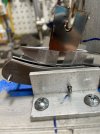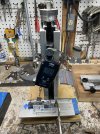Sean Yaw
Gold Member
- Joined
- Feb 26, 2019
- Messages
- 418
How do you slipjoint makers get a super smooth action? I am guessing it seems to be a tradeoff of tang/spring-tip sanding grit, tang corner rounding radii, and spring tension. I have a slipjoint from Bill Ruple that is exquisitely smooth, but I haven't been able to get mine to feel like that. Even on my good ones, I can feel slight grittiness when opening/closing the blade slowly without letting it snap to the next position. I'd appreciate any tips people have. Thank you.


